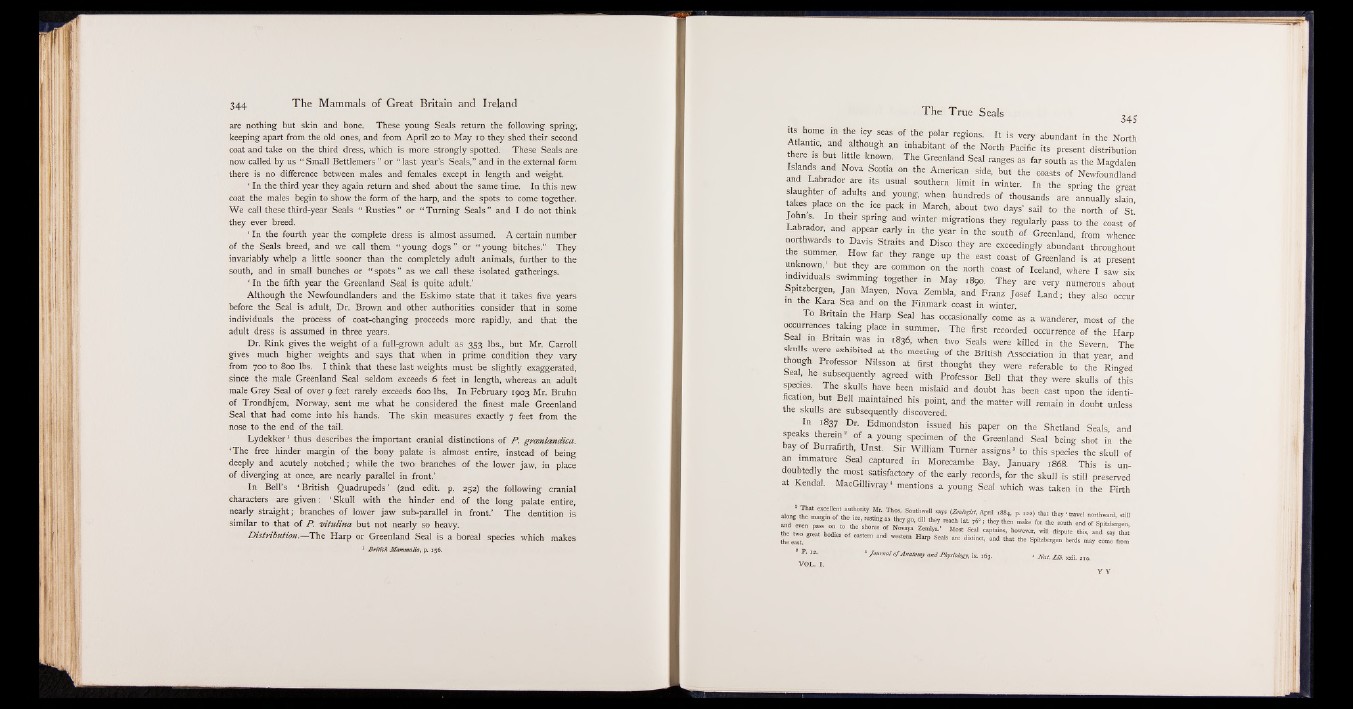
are nothing but skin and bone. These young Seals return the following spring,
keeping apart from the old ones, and from April 20 to May 10 they shed their second
coat and take on the third dress, which is more strongly spotted. These Seals are
now called by us “ Small Bettlemers ” or “ last year’s Seals,” and in the external form
there is no difference between males and females except in length and weight.
‘ In the third year they again return and shed about the same time. In this new
coat the males begin to show the form of the harp, and the spots to come together.
We call these third-year Seals “ Rusties ” or “ Turning Seals ” and I do not think
they ever breed.
‘ In the fourth year the complete dress is almost assumed. A certain number
of the Seals breed, and we call them “ young dogs ” or “ young bitches.” They
invariably whelp a little sooner than the completely adult animals, further to the
south, and in small bunches or “ spots ” as we call these isolated gatherings.
‘ In the fifth year the Greenland Seal is quite adult.’
Although the Newfoundlanders and the Eskimo state that it takes five years
before the Seal is adult, Dr. Brown and other authorities consider that in some
individuals the process of coat-changing proceeds more rapidly, and that the
adult dress is assumed in three years.
Dr. Rink gives the weight of a full-grown adult as 353 lbs., but Mr. Carroll
gives much higher weights and says that when in prime condition they vary
from 700 to 800 lbs. I think that these last weights must be slightly exaggerated,
since the male Greenland Seal seldom exceeds 6 feet in length, whereas an adult
male Grey Seal of over 9 feet rarely exceeds 600 lbs. In February 1903 Mr. Bruhn
of Trondhjem, Norway, sent me what he considered the finest male Greenland
Seal that had come into his hands. The skin measures exactly 7 feet from the
nose to the end of the tail.
Lydekker1 thus describes the important cranial distinctions of P . grwnlandica.
‘The free hinder margin of the bony palate is almost entire, instead of being
deeply and acutely notched; while the two branches of the lower jaw, in place
of diverging at once, are nearly parallel in front.’
In Bell’s ‘ British Quadrupeds’ (2nd edit. p. 252) the following cranial
characters are given: ‘ Skull with the hinder end of the long palate entire,
nearly straight; branches of lower jaw sub-parallel in front.’ The dentition is
similar to that of P. vitulina but not nearly so heavy.
Distribution.— The Harp or Greenland Seal is a boreal species which makes
1 British Mammalia, p. 156.
3 4 S SHI HD D B P° ar BDH iS H abundant i” the North
Atlantic, and although an inhabitant of the North Pacific its present distribution
there but little known. The Greenland Seal ranges as far south is the Magdalen
Islands and Nova Scotia on the American side, but the coasts of Newfomdland
and Labrador are its usual southern limit in winter. In the spring the great
slaughter of adults and young, when hundreds ■ thousands are annually skin
takes place on the ice pack in March, about two days’ sail to the north of St
M , nS. lD *Jelr Spnn8: and Wlnter “ Stations they regularly pass to the coast of
Labrador and appear early in the year in the. south of Greenland, from whence
northwards to Davis Straits and Disco they are exceedingly abundant throughout
e summer How far they range up the east coast of Greenland & at present
unknown but they are common on the north coast of Iceland, where I saw six
individuals swimming together in May 1890. They are very numerous about
Spitsbergen, Jan Mayen, Nova Zembla, and Franz Josef Land; they alsSFÔocür
in the Kara Sea and on the Finmark coast in winter.
To Britain the Harp Seal has occasionally come as a wanderer, most of the
occurrences taking place in summer. The first recorded occurrence of the Harp
Seal m Britain was in r836, when two Seals were killed in the Severn The
skulls were exhibited at the meeting of the British Association in that year, and
though Professor Nilsson at first thought they were referable to the Ringed
Seal, he subsequently agreed with Professor Bell that they were skulls of this
species. The skulls have been mislaid and doubt has been cast upon the identi-
fication, but Bell maintained his point, and the matter will remain in doubt unless
the skulls are subsequently discovered.
In 1837 Dr. Edmondsfon issued his paper on the Shetland Seals, and
speaks therein of a young specimen of the Greenland Seal being shot in the
bay of Burrafirth, Unst. Sir William Turner assigns' to this species the skull of
an immature Seal captured in Morecambe Bay, Januaiy 1868. This' Ü undoubtedly
the most satisfactory of the early records, for the skull «'is still preserved
at Kendal. MacGillivray« mentions a young Seal which was taken in the Firth
I2‘ 3 M m ol of Anatomy and Physiology, ix. 163. 4 ^.ib xxii 210
VOL. I.
Y Y